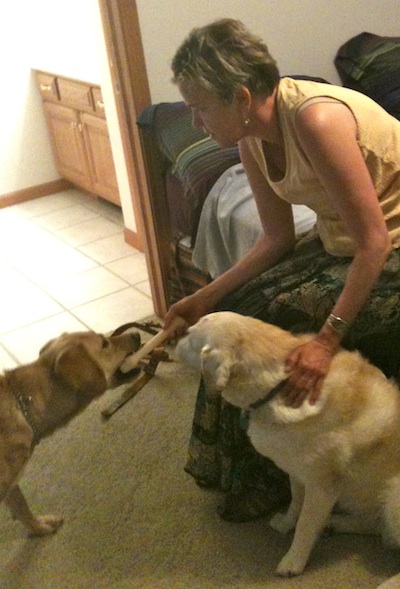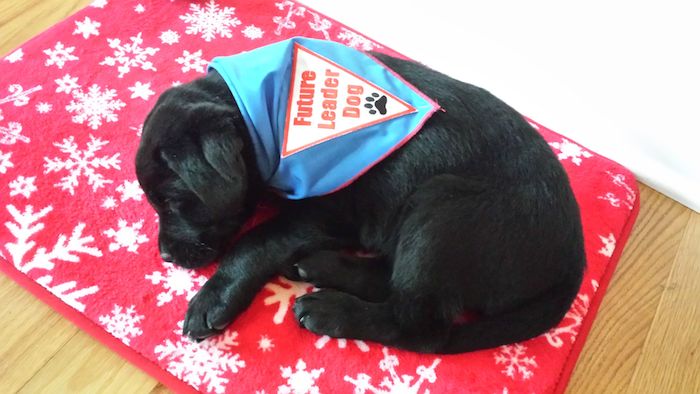Do Seeing Eye dogs really know their left from their right?
January 14, 2015 • 12 Comments • Posted in blindness, Mike Knezovich, questions kids ask, Seeing Eye dogs, Uncategorized, visiting schoolsWhitney usually leads me to the train station in downtown Chicago on her own, but when my gem of a husband, Mike Knezovich, generously offered to walk us this morning, I said “YES!” Reasons:
- Freezing temperatures — if Whitney and I got lost or turned around for just a few minutes, we’d end up with frostbite!
- Snowy slippery sidewalks
- Salt (Mike can spot it on the roads and help us avoid those areas so it doesn’t end up in Whit’s paws)
- The train we’re catching leaves at 7:52 a.m., which means we’ll be approaching the train station precisely when commuters are getting off trains and rushing to work
Today marks the start of our 2015 year of visits to schools — we’re heading to the Joseph Sears School in suburban Kenilworth. We were at Sears School last year about this time, and the kindergartners squealed with delight when Whitney led me in wearing snow boots on her paws. “That‘s our special guest Mrs. Fink,” their teacher announced. “And that’s Hanni, the dog from the book, too!”
We’d arrived late to Sears School last year (our commuter train had been delayed in Chicago due to weather) and our opening assembly had to be cut back to 15 minutes. After that, Whit and I gave separate fifteen-minute sessions for each and every kindergarten and first grade class.
Fifteen minutes was not enough time to explain that my last name, Finke, rhymes with “Pinky” and really, I prefer you call me Beth, that Hanni, the star of my book Hanni and Beth: Safe & Sound, had retired, that this was a new dog, I’d had to decide when it was time for Hanni to retire, I could have kept Hanni as a pet or brought her back to the Seeing eye but I decided to find friends to adopt her, that she’s doing fine and is living an enviable retirement in Urbana, that I had another dog after that, his name was Harper, he retired early and lives in Wheaton with friends, and now, this new dog is Whitney, a sassy urban girl who is a ball of energy.
And so, I did what I had to do. I referred to the dog at my feet generically. She was “my Seeing Eye dog.” Ick snay on it-whey ee-nay. The questions during the classroom visits last year reflected what the kindergartners and first-graders were learning to do in school:
- How do you put on your shoes?
- How can you print your name if you can’t see the paper?
- How do you read those green signs that tell you what street it is?
- How do you get dressed?
- Can you tell time?
- Does your dog really know right from left?
I was honest with the little girl who asked that last question. I really wasn’t sure. “We say the word ‘left’ when we want our dogs to turn left,” I told her. I went on, then, explaining how Seeing Eye trainers teach us to point to the left and face our shoulders left, too, at the same time we give the “left” command. “So I don’t know if my Seeing Eye dog understands the word ‘left’ or she sees my body language….” I could hear the kids starting to fidget. I was losing my audience, so I stood up to show them how it works.
In the real world, out on the street, a blind person memorizes or knows the route before leaving home. The pair gets themselves situated on the sidewalk and faces the direction they’ll start. The blind person commands “Forward!” and the dog guides them safely to the curb. When the dog stops, the person stops. That’s how a blind person using a guide dog knows they have arrived at an intersection.
If the person wants to turn right or left at that corner, the person commands the direction, simultaneously turning their upper body in that direction and pointing in that direction, too. The dog turns, and the blind companion follows the dog’s lead.
Back in the school classroom, I woke up the dog sleeping at my feet and lifted the harness off her back. And then, uh-oh, it dawned on me. These kids all thought my dog was Hanni.
Dog is my co-pilot. I offered a quick prayer. “Please, Whitney, go along with the ruse.” Pointing both shoulders and my pointer finger left, I commanded, “Hanni, left!” My Seeing Eye dog turned left with more exuberance than usual. She was onto the fake. I gave her another command. “Hanni, outside!” Whitney led me to the door.
This morning we should be there in plenty of time for me to explain to the students that Hanni, the star of Safe & Sound, has retired, and Whitney is my new dog. Our school visits this past year taught me that the kids are intrigued by a dog “retiring,” and it makes them feel special to meet the young dog – especially when she misbehaves and I have to put her through her obedience ritual. “It’s like a time out!” a boy at one school we visited exclaimed.
Just pressed the button on my talking clock. “It’s 5:52 a.m.” Uh-oh. Time to get ready. Wish us luck!




